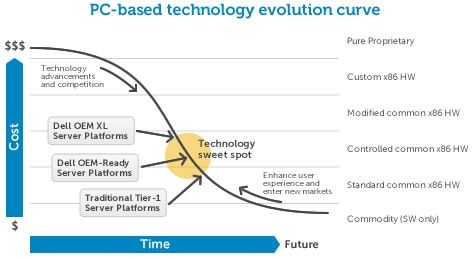One of the first things I learned when I started supporting OEM customers with their technical hardware requirements was how difficult it can sometimes be to move a solution from one platform to a new platform. That transition pain is increased when the hardware supplier warns of an end of life date for the current platform which is not far enough in the future to allow for a full development and test cycle on the new hardware. In those days, Dell had a policy of overlapping platforms by at least 90 days. That meant that one a new platform was released to ship the old platform would remain available to order for at least 90 days. This gave our OEM customers at least 90 days to develop with, test, QA, and ship their solutions on the latest platforms before their previous platforms went away. Sometimes 90 days simply isn’t enough time.
As Dell OEM Solutions expanded and added services and capabilities, we were able brilliantly employ Dell’s phenomenal supply chain prowess to increase the overlap period between old and new platforms to a standard 180 days, based on careful forecasting and planning on the part of our customers to predict the volume demand of the soon to discontinue platforms. That practice, which has improved to the point of being commonplace for our organization, is now a key value that helps us build new business relationships and continues to make our customers quite happy and successful. However, even 6 months can be a short period when developing on new hardware for certain complex and critical solutions.
Beginning last spring when Intel released the “Westmere” iteration of their XEON 5000 series dual processor CPUs which required a slight modification to the “Nehalem” class motherboards, Dell OEM Solutions introduced a new program for extended life platforms. We call this program PowerEdge OEM Ready XL. The new XL (extended life) platforms provide no less than 12 months of availability of the previous generation hardware after the release of new hardware intended to replace the old. That means that when the “Westmere” motherboards were released on the PowerEdge R610 and PowerEdge R710 servers, the XL platforms offered the pre-Westmere, or “Nehalem,” motherboard iterations with “Nehalem” CPUs for 12 months. This gave our OEM customers the ability to continue shipping Nehalem platforms for up to 12 months as they tested their solution on the new CPU and motherboard.
This month a new version of the PowerEdge OEM Ready R610 XL and R710 XL supporting the most recent motherboard iteration and the current Westmere series of CPUs will be released in the US and soon after in the European and Asian markets. This new version will be a controlled platform on which OEM customers can develop their products and solutions. With controlled change, extended lifecycles, and the myriad of services and capabilities Dell OEM Solutions can bring, the XL platforms are narrowing the gap between custom built hardware platforms and mainstream value platforms. By the end of the year our customers will be able to get four different platforms in the XL family, the Dell PowerEdge R610 XL, PowerEdge R710 XL, PowerEdge T710 XL and PowerEdge R210 XL.
While these platforms allow for a longer development cycle on new hardware, they are not a bridging solution to skip platform generations. We are still relying on Dell supply chain capabilities to manufacture products on demand. The value of moving closer to a mainstream value platform, i.e. lower cost, current technologies, riding the high volume market principles, manufacturing quality, etc., all still apply to the XL program. We are enabling improved transition planning for our OEM customers. Please let me know how this helps your solution development process.
If you are interested in learning more, please let us know. If you have other ideas for improving our offerings while maintaining all the principles and values our customers rely upon, also let us know.
COTS, Extended Life, long life, OEM, oem ready, PowerEdge, Server
